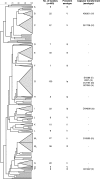Evidence for rare capsular switching in Streptococcus agalactiae
- PMID: 20023016
- PMCID: PMC2820851
- DOI: 10.1128/JB.01130-09
Evidence for rare capsular switching in Streptococcus agalactiae
Abstract
The polysaccharide capsule is a major antigenic factor in Streptococcus agalactiae (Lancefield group B streptococcus [GBS]). Previous observations suggest that exchange of capsular loci is likely to occur rather frequently in GBS, even though GBS is not known to be naturally transformable. We sought to identify and characterize putative capsular switching events, by means of a combination of phenotypic and genotypic methods, including pulsed-field gel electrophoretic profiling, multilocus sequence typing, and surface protein and pilus gene profiling. We show that capsular switching by horizontal gene transfer is not as frequent as previously suggested. Serotyping errors may be the main reason behind the overestimation of capsule switching, since phenotypic techniques are prone to errors of interpretation. The identified putative capsular transformants involved the acquisition of the entire capsular locus and were not restricted to the serotype-specific central genes, the previously suggested main mechanism underlying capsular switching. Our data, while questioning the frequency of capsular switching, provide clear evidence for in vivo capsular transformation in S. agalactiae, which may be of critical importance in planning future vaccination strategies against this pathogen.
Figures



Similar articles
-
Molecular epidemiology of group B streptococci in Ireland reveals a diverse population with evidence of capsular switching.Eur J Clin Microbiol Infect Dis. 2014 Jul;33(7):1155-62. doi: 10.1007/s10096-014-2055-5. Epub 2014 Jan 28. Eur J Clin Microbiol Infect Dis. 2014. PMID: 24469423
-
Capsular switching in group B Streptococcus CC17 hypervirulent clone: a future challenge for polysaccharide vaccine development.J Infect Dis. 2012 Dec 1;206(11):1745-52. doi: 10.1093/infdis/jis605. Epub 2012 Sep 21. J Infect Dis. 2012. PMID: 23002446
-
Capsular gene typing of Streptococcus agalactiae compared to serotyping by latex agglutination.J Clin Microbiol. 2013 Feb;51(2):503-7. doi: 10.1128/JCM.02417-12. Epub 2012 Nov 28. J Clin Microbiol. 2013. PMID: 23196363 Free PMC article.
-
Molecular epidemiology and distribution of serotypes, surface proteins, and antibiotic resistance among group B streptococci in Italy.J Clin Microbiol. 2007 Sep;45(9):2909-16. doi: 10.1128/JCM.00999-07. Epub 2007 Jul 18. J Clin Microbiol. 2007. PMID: 17634303 Free PMC article.
-
Streptococcus agalactiae pulsed-field gel electrophoresis patterns cross capsular types.Epidemiol Infect. 2009 Oct;137(10):1420-5. doi: 10.1017/S0950268809002167. Epub 2009 Mar 4. Epidemiol Infect. 2009. PMID: 19257912 Free PMC article.
Cited by
-
Molecular epidemiology of Streptococcus agalactiae isolated from mastitis in Brazilian dairy herds.Braz J Microbiol. 2017 Jul-Sep;48(3):551-559. doi: 10.1016/j.bjm.2017.02.004. Epub 2017 Feb 16. Braz J Microbiol. 2017. PMID: 28256391 Free PMC article.
-
Alterations in Genes rib, scpB and Pilus Island Decrease the Prevalence of Predominant Serotype V, Not III and VI, of Streptococcus agalactiae from 2008 to 2012.Pathogens. 2022 Oct 3;11(10):1145. doi: 10.3390/pathogens11101145. Pathogens. 2022. PMID: 36297202 Free PMC article.
-
Development and Application of a Prophage Integrase Typing Scheme for Group B Streptococcus.Front Microbiol. 2020 Aug 31;11:1993. doi: 10.3389/fmicb.2020.01993. eCollection 2020. Front Microbiol. 2020. PMID: 32983017 Free PMC article.
-
Virulence Profiles and Antimicrobial Resistance of Streptococcus agalactiae Infective and Colonizing Strains from Argentina.Curr Microbiol. 2022 Nov 3;79(12):392. doi: 10.1007/s00284-022-03050-w. Curr Microbiol. 2022. PMID: 36329271
-
Capsular Switching and ICE Transformation Occurred in Human Streptococcus agalactiae ST19 With High Pathogenicity to Fish.Front Vet Sci. 2018 Nov 13;5:281. doi: 10.3389/fvets.2018.00281. eCollection 2018. Front Vet Sci. 2018. PMID: 30483518 Free PMC article.
References
-
- Bidet, P., N. Brahimi, C. Chalas, Y. Aujard, and E. Bingen. 2003. Molecular characterization of serotype III group B-streptococcus isolates causing neonatal meningitis. J. Infect. Dis. 188:1132-1137. - PubMed
-
- Brochet, M., E. Couvé, M. Zouine, T. Vallaeys, C. Rusniok, M. Lamy, C. Buchrieser, P. Trieu-Cuot, F. Kunst, C. Poyart, and P. Glaser. 2006. Genomic diversity and evolution within the species Streptococcus agalactiae. Microbes Infect. 8:1227-1243. - PubMed
Publication types
MeSH terms
Substances
Associated data
- Actions
LinkOut - more resources
Full Text Sources

